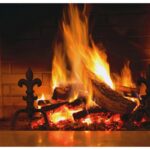In order to keep a fire going, you need to build a good fire in the first place, provide it with plenty of food (wood and oxygen), and potentially do some troubleshooting along the way.

This is a complete guide on how to keep a fire going, including tips for building and maintaining a good fire, as well as considerations regarding safety and the environment.
Building A Good Fire
To build a good fire, you will need to following materials
- A lighter (or matches)
- Kindling
- Newspaper
- Wood (dry)
You’ll also need a fire poker to stoke the fire, and a fireguard for safety purposes.
Clean Your Fireplace
If your fireplace is dirty with ashes, your fire might not burn properly. You shouldn’t have more than an inch of ash in your fireplace. If the ash has accumulated to more than this, sweep it out before you get started.
Reverse The Draft
Make sure there’s no draft coming down your chimney flue before you light your fire. You can reverse any draft by rolling up some of your newspaper, lighting it, and holding it in the damper until you feel the draft going the other way.
Position Newspaper Under Grate
Take the rest of your newspaper and lay it evenly under your grate.
Cross The Kindling
You should lay out your kindling using the crisscross method, crossing one piece of kindling over another.
Light Your Newspaper
You don’t need to do this too many times. Just find a couple of spots to light and make sure the fire spreads.
Place The Wood
Arrange your wood on top of the kindling. Try to prop it up in a teepee shape. This allows the air to circulate between the pieces of wood, so it will catch on fire more easily.
Use your poker to place the wood where you want it and avoid burning your hands.
Note: It’s very important that your kindling and wood are both dry. Otherwise, they won’t catch alight properly. Ideally, you should opt for a hard wood that is non-resinous. Maple, ash, or oak will work best.
Keeping The Fire Going

Building a good fire is only part of the equation. You’ll need to take steps once the fire is lit to ensure that it doesn’t go out.
1. Open A Window
This probably seems counterintuitive if you’re trying to keep the room warm with a fire, but opening a window will help oxygen to reach the flames and encourage a steady burn.
2. Arrange Wood With Poker
Another way to ensure a steady flow of oxygen to your fire is to use the poker to keep space between pieces of wood. If you allow the wood to get packed together, the air flow won’t be optimal.
3. Don’t Add Too Much Wood
It can be tempting to add lots of wood on top of your fire, but adding too much wood too quickly can actually suffocate the flames. Before adding more wood, wait until the fire has started to burn down.
Then, add small pieces of wood, making sure that they are spaced out enough to allow for air flow in between.
4. Adjust Heat Output
There are ways to regulate the intensity and heat output of your fire. If you want to cool down your heat output, rearrange the logs in an east-west configuration. For more intense heat, arrange them north-south instead.
The north-south configuration also allows your logs to burn for longer.
Packing the logs more densely (while still leaving room for air circulation) will provide better heat output, while loosely-packed, smaller logs will produce less heat.
You can boost your fire’s intensity by using your poker to create more space for air flow, or adding more kindling to the fire.

Troubleshooting A Fire
Here are some common fire problems and how to fix them:
1. Fire Keeps Burning Out
This could be because you’ve actually left too much room for air. This can cause inefficient burning. Use your poker to close up the gaps slightly (not too much) and see if this helps.
Alternatively, if your wood is packed together too closely, try moving the pieces of wood apart slightly.
2. Fire Producing Too Much Smoke
Check the damper and the flue. If the damper is partially shut, or the flue is obstructed, smoke will pour into the room instead of exiting via the chimney.
Open the damper or, if the flue is obstructed, put out the fire and remove the obstruction before lighting it again.
Safety Considerations
Safety should always come first when working with fire. Here’s what you need to remember:
- Don’t leave a fire unattended
- Wear hand protection when using a poker to adjust logs in an active fire
- Make sure your flue is unobstructed and that your room is ventilated before you light your fire to prevent smoke inhalation
- Never light a fire with the damper closed, since this could cause smoke to pour into the room
- Under no circumstances should you use gasoline or any other flammable chemicals to light your fire
- Use a fireguard to keep your fire contained in the grate
Sustainability And Environmental Concerns
If done incorrectly, lighting a fire can impact the environment. These are the steps you should take to burn fires sustainably:
- Get regular chimney inspections to reduce the risk of chimney fires
- Don’t burn household waste in your fire, since this can produce damaging fumes
- Recycle or reuse firewood packaging
- Dispose of your ash in a sealed bag or put wood ash in your compost
- Consider using compressed wood chips or sawdust as eco-friendly alternatives to burning wood
- Only light a fire when you need to
Conclusion
To keep a fire burning, you need to build it correctly from the start, using the teepee formation and spacing out the logs for air flow.
Only add wood when your fire starts burning out, and open a window at the start of the process to ventilate the room and provide more oxygen. Adjust your logs as needed using your poker.
- How To Open Chimney Flue - July 20, 2023
- Do Electric Fireplaces Use A Lot Of Electricity? - July 20, 2023
- How To Keep A Fire Going - July 20, 2023








